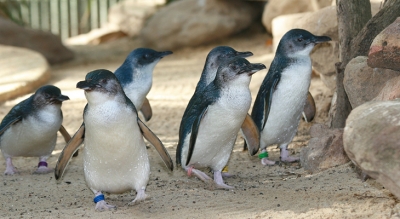
The blue penguin, also little penguin or fairy penguin is the smallest of all known penguin species. Found on the coastlines of southern Australia and New Zealand, it grows to an average height of 33 cm and weighs no more than a kg.
Although the length of the breeding season varies by subspecies and geography, it generally occurs between June and December. Breeding pairs tend to nest in hidden areas that are relatively free of mammalian predators—such as on cliff crevices, in ground burrows, in caves, or under vegetation. Compared with other penguin species, most blue penguins are monogamous; pair breakups are uncommon, occurring only after unsuccessful nesting attempts. Breeding pairs also tend to return to the same nests year after year, and some pairs occupy the same nest year-round.
If mating is successful, a clutch of two eggs is produced. Each parent takes a turn incubating the eggs, while the other returns to sea to feed. This pattern continues after the eggs hatch some 35–37 days later, at which point the parents take turns supplying the chicks with food. The parents also take turns guarding the chicks until the chicks are 18–38 days old. Unlike other penguin species, however, older blue penguin chicks tend to remain in the nest during the day when both parents are out hunting. In general, they do not form “crèches” (groups) with chicks from other nests; however, some studies note that crèches may form among blue penguin chicks that nest in large caves. Fledging, the stage in which the young transition to adulthood, takes place when the chicks are between 50 and 65 days old. During this stage, the young forage in the sea for the first time. Although some may leave the nest during this period, most will remain with their parents before becoming fully independent a few weeks later. Most males and females reach sexual maturity at age three. While the life span of the blue penguin is generally six to seven years, some studies note that a few individuals can live as long as 25 years in the wild.
Credit : Britannica
Picture Credit : Google




